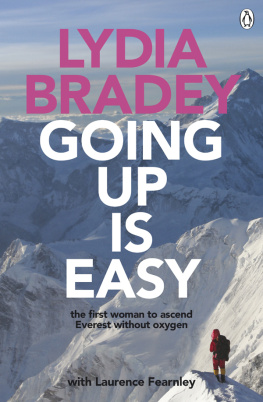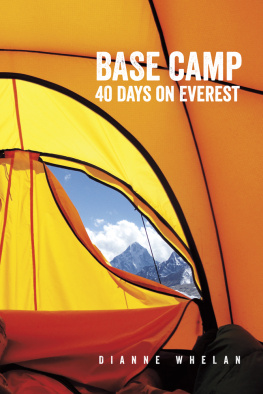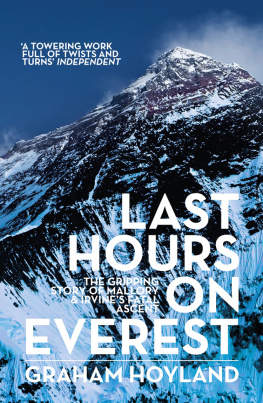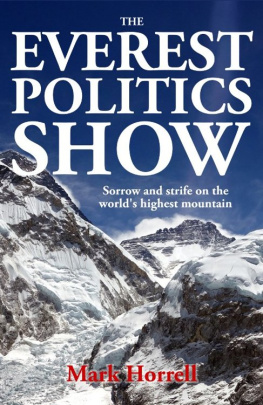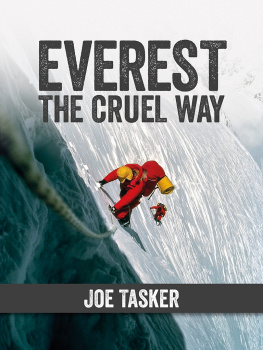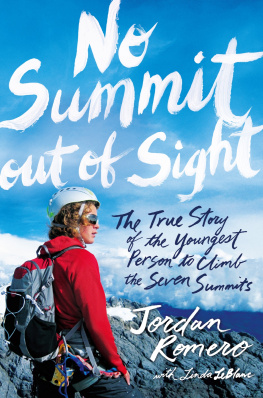Contents
Guide
Pagebreaks of the print version

The author and publisher have provided this e-book to you for your personal use only. You may not make this e-book publicly available in any way. Copyright infringement is against the law. If you believe the copy of this e-book you are reading infringes on the authors copyright, please notify the publisher at: us.macmillanusa.com/piracy.
For all those who have yet to climb
you are not alone.
If I can count to one thousand, I can get through this.
1, 2, 3
Im going for a walk. Thats it. Just a walk. A very long, very steep, potentially deadly walk up Lhotse Face, a four-thousand-foot vertical wall of blue ice rising from the Western Cwm.
The Valley of Silence.
My mind is anything but silent, and from where I stand, Lhotse is a slick, shimmering beast.
An alpine skyscraper.
Just before the wall is a bergschrund, a gaping crevasse where the glacier has cracked and pulled away from the mountain. The mornings gluten-free oats sit heavy in my gut as I stare down into its immensity. Its wide mouth gapes, hungry.
Then a sound.
A glove falls and slips into the void. I watch it disappear and stare long after its gone, hoping it will magically re-emerge.
None of the other climbers says a word, and one by one we climb over a field of shaggy rocks and cross a ladder over the bergschrund.
I focus on the ropes. Two skinny lines snaking up the icy face of Lhotse. One for us, the climbers going up, the other for those descending. The ropes are no thicker than my thumb but will guide us up a vertical mile like a handrail on a flight of stairs. In my mind, they morph into velvet ropes leading us toward a mysterious, exclusive nightclub where both the dancers and the drinks are flowing. A blackout drunk experience is way less terrifying than this.
A few steps off the route, unclipped, and I would become the glove. A quick and quiet slip into a vast and endless death.
In other words, its all up from here.
17, 18, 19
Mike, the head guide, is leading us up Lhtose, followed by Danny and Brian, the fastest and strongest of the climbers, with Ang Dorjee close behind. Mark and I keep pace in the middle, our sweet spot, and bringing up the rear is Lydia Bradey, an Everest legendthe first woman to summit without oxygen. Rob, another member of our team, who had been struggling, wasnt healthy enough to climb past Camp 2.
33, 34
At breakfast, Mike said it would take just under five hours to scale the Face. I extend the safety carabiner from my harness, then open the jumar and feed it with the first fixed rope on my left. Attached to the climbing harness that cradles my hips and upper thighs, the jumar is a hand brake, or a ratcheting handle, which slides up the rope one way and pulls taut when weight is applied. Slowly I begin to walk, sliding my jumar up the rope, pushing my fingers deep into the glove so I can feel what Im gripping through the bulky material. My gloves are baggy as always. Elite mountaineering gear is still designed for men, and even the extra-small gloves gape around my hands.
Ive learned to make do.
When I first started climbing, the jumar was a symbol. The thing that made me a real climber. A tool to master for entrance into the cool-kid climbers club. After a decade of climbing and reaching five of the Seven Summitsthe tallest mountain on each continentIm still a nerdy kid trying to fit in, but the jumar is no longer a flashy piece of equipment. Its an extension of me. My lifeline, my anchor, it doesnt unclip unless I do.
I respect the jumar. I bow to the jumar.
And every time I feel its steel teeth bite down on rope, I let out a hushed yes.
55, 56, 57
Leveraging my ice axe like a cane, I chop it into the wall and kneel into the incline to stabilize myself. Walking in cramponsstrap-on metal cleatsis a tedious art. They dig into the hardened snow and ice to provide traction. Luckily, I share the same short gait as most of the Sherpas, who have already climbed ahead to set up camp for the night. I space out my steps to hit the tiny ledges their boots have cut into the ice. Not having to chop into virgin ice saves a sliver of energy, and Im hoarding whatever juice I can. Every step must be precise and mechanical.
Deep breath and exhale. Emotions are dangerous at this elevation. Focus. Count. 61. 62. No feelings. Count. No emotions. Count. 84. 85 .
Were thirty-six hours from summit, I think. Two camps to go. Id try to calculate the miles, but they mean nothing anymore. This high on the mountain, distance is abstract. Granular, even. Our days are measured in landmarks and elevation gain. Camp 3. 24,500 feet. Camp 4. Yellow Band. Geneva Spur. South Col. 26,300 feet. Altitude owns us. Its hard to grasp what is near and what is far. Time expands and contracts. Perspective shifts quickly. Zoomed out, were ants in formation, tiny black dots pushing up the side of a colossal mountain range. But my field of vision is microscopicall I see is the shimmer and the crumble of the wall Im climbing at this very moment.
At this altitude, were higher than most birds will ever fly.
I wonder if birds do this. Get obsessed with height. Try to fly higher than each other.
93, 94, 92
Shit. Start again.
1, 2, 3
Somewhere behind this wall is the summit. Or is it above?
Why didnt I memorize this route better?
Lhotse is the final obstacle before Camp 3 and where our oxygen tanks are waiting. Above 24,000 feet, the climb is a race against diminishing oxygen. This high, we rest, but we dont recover. We are deteriorating. Strapped to our backs like newborns in a manta, the oxygen tanks will become our most precious cargo. Without them, wed be done. Everyone except Lydia, maybe. The last chance for rescue is behind us, anyway. Helicopters dont fly higher than Camp 2. Any kind of rescue now, even to bring back a dead body, has to be done step-by-step, on foot, down the ropes.
24, 25, 23
Shit. Again. Keep beginning again.
1, 2, 3
The wind is picking up.
The days usual banter and shit-talking have gone silent, replaced by baritone huffs and grunts. Everyone is focused on their next step.
Rock! Brian shouts suddenly from above. He swerves to the right as a basketball-sized rock tumbles down Lhotse.
Rock! Rock! Rock! The word echoes through us. We all swerve right. 22, 23, 24 Another team slips quietly past on the descending rope, coming down from Camp 3. Its unsettling to watch them descend while everyone else on the mountain is thinking up up up . Its May 17. This is the summit window. Going down means something has gone wrong. As they pass, I realize I havent seen any other teams this morning. Were the only ones on the Face.
Fifteen minutes later, the wind begins to whistle and groan.
Ice! hollers Ang Dorjee.
Ice.
Ice.
Ice.
Something isnt right.
Halfway up, we hit a bulge, a dangerous rocky outgrowth covered in the ethereal sky-blue ice that forms when snow falls onto a glacier. The bulge is a beautiful icy scab we have to wriggle our bodies over while executing a complicated change of ropes.
Each fixed rope up Lhotse is about 150 feet long. At the end of a segment, we have to unclip our jumar from the climbing harness and attach it to the next rope. The moment between ropes is the most dangerous. It is a two-step process: you must always remain attached to the fixed line by at least one device to avoid slipping down the wall.


